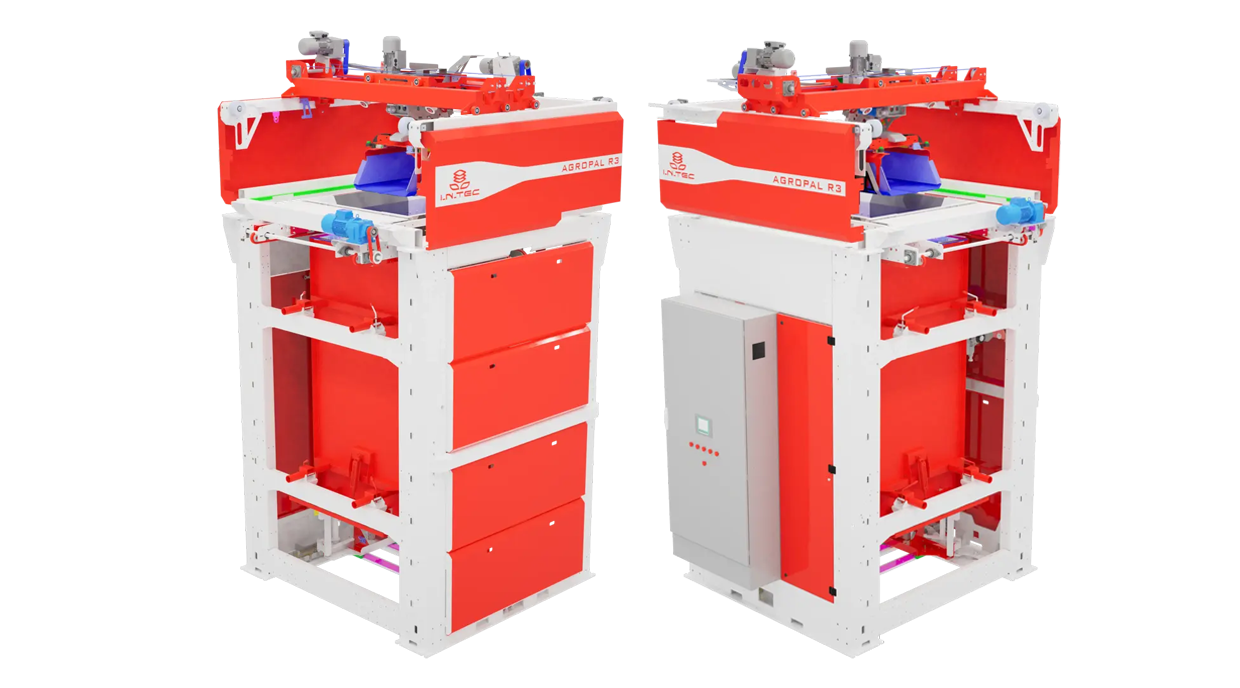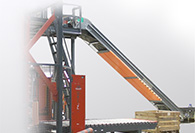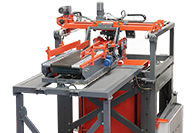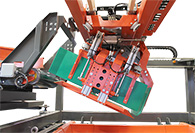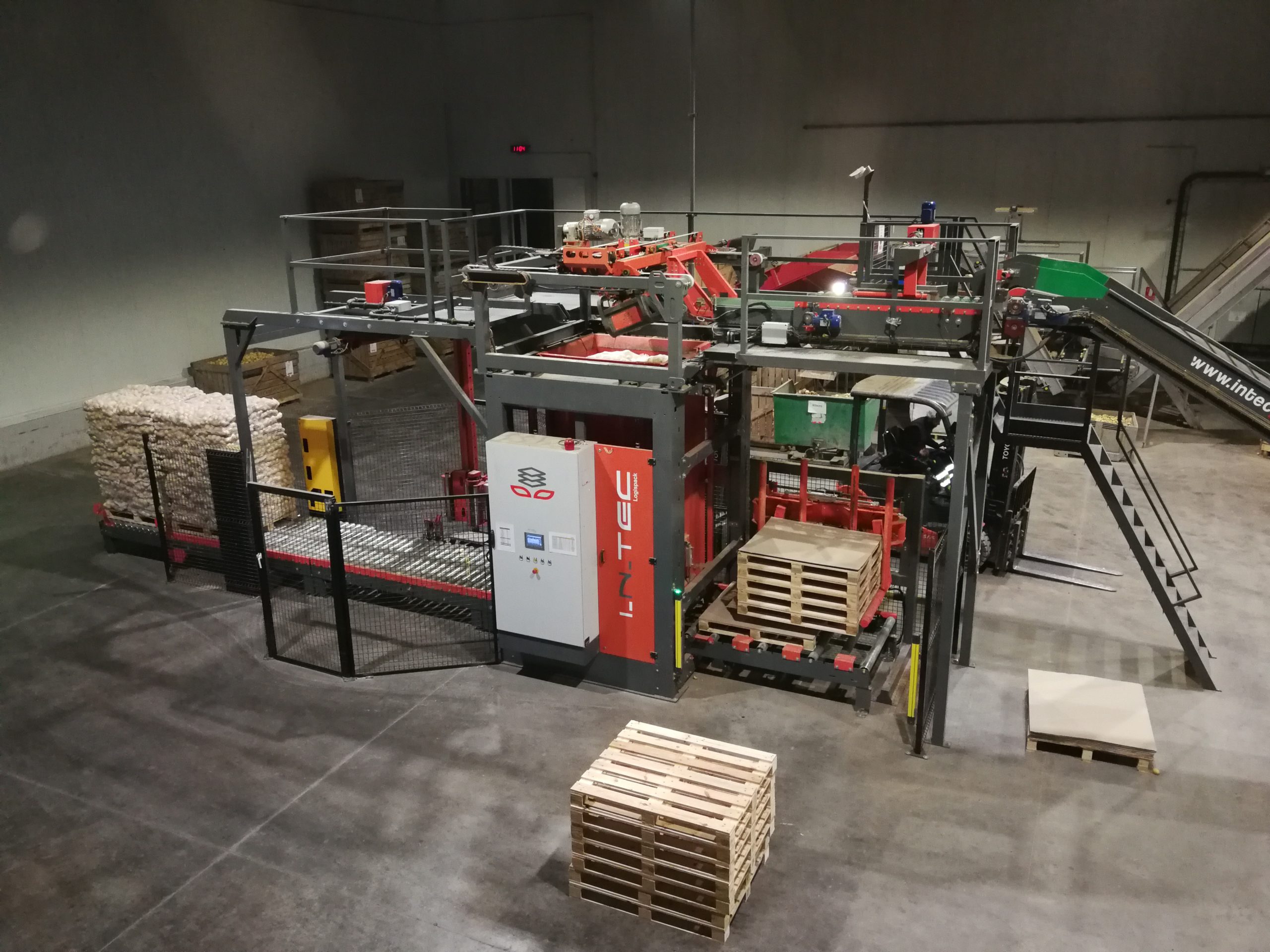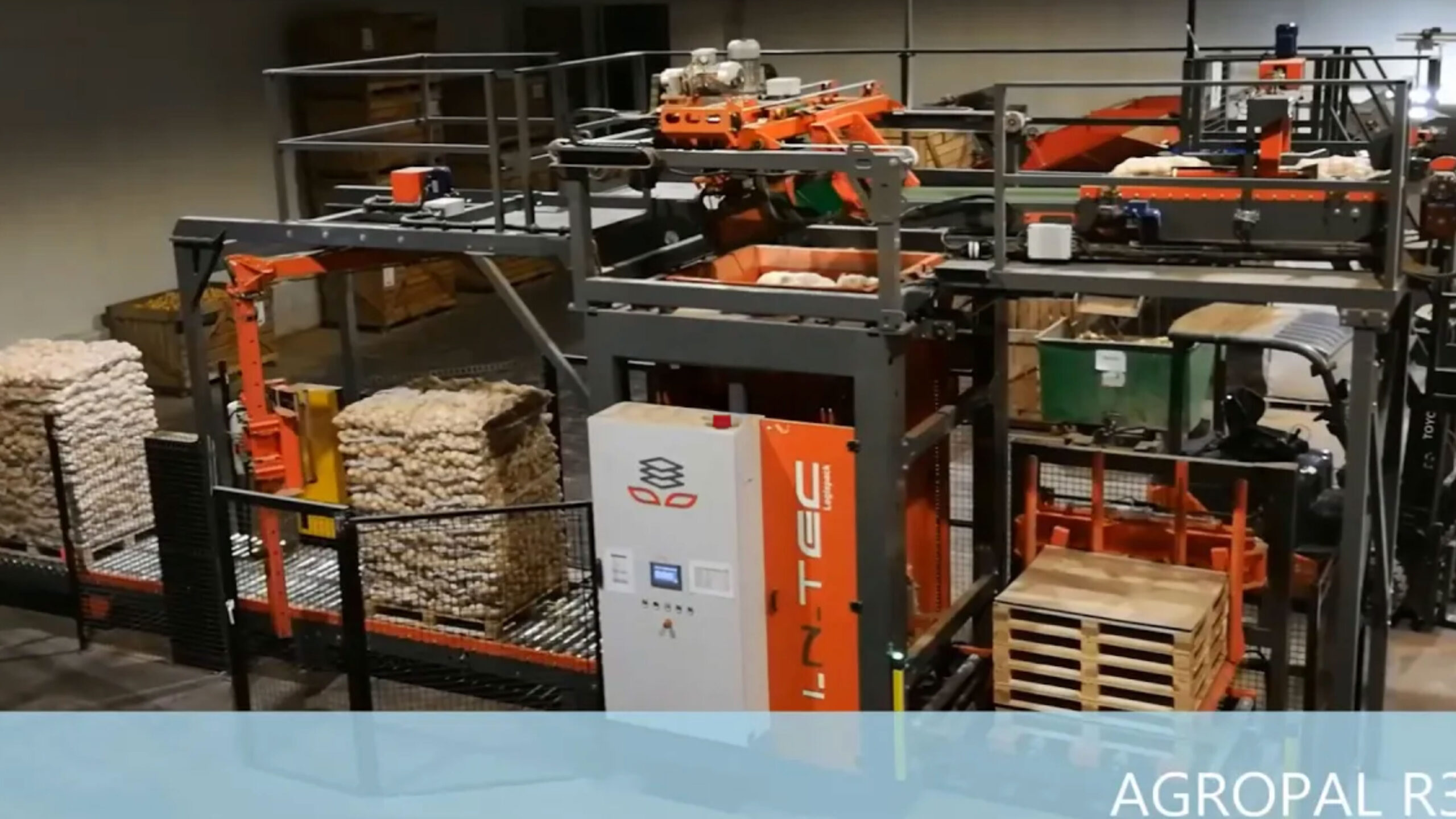- Equipment
- INTEC Agropal R3 Palletizer
INTEC Agropal R3 Palletizer
INTEC Agropal R3 Palletizer
Works With
Details
Like all Intecpal palletizers, the INTEC Agropal R3 is specifically designed for products with great stacking difficulties. This palletizer discharges the product vertically over the pre-layer zone and load assembly inside a mold with frontal and lateral opening capacity. The Agropal R3 also automatically adapts to different pallet widths.
Key Features and Benefits
- Synchronized opening grip and lateral presses. It has a tilt action to receive bags from the fast belt.
- 3 axis Robot-Portico, programmable and motorized to locate the delivery point over the gates
- Layer dimension lateral adjustment through some adjustable chutes with different widths
- Synchronized gates for layer preparation
- Pneumatic mold opening with pneumatic-mechanical closure
- Pallet extraction rollers
- Lifting platform
- Electric cabinet with radial displacement to optimize cleaning and maintenance
- Telescopic belt
- Ribbed belt
- Production of 1.500 maneuvers/hour*Palletizing available from 11 lbs to 50 lbs.
Visit Intecpal at www.intecpal.com/en/ for more information.
See all Fox Solutions equipment for advanced automation in fresh produce packaging.
Works With
 Avocados
Avocados
 Pears
Pears
Details
Like all Intecpal palletizers, the INTEC Agropal R3 is specifically designed for products with great stacking difficulties. This palletizer discharges the product vertically over the pre-layer zone and load assembly inside a mold with frontal and lateral opening capacity. The Agropal R3 also automatically adapts to different pallet widths.
Key Features and Benefits
- Synchronized opening grip and lateral presses. It has a tilt action to receive bags from the fast belt.
- 3 axis Robot-Portico, programmable and motorized to locate the delivery point over the gates
- Layer dimension lateral adjustment through some adjustable chutes with different widths
- Synchronized gates for layer preparation
- Pneumatic mold opening with pneumatic-mechanical closure
- Pallet extraction rollers
- Lifting platform
- Electric cabinet with radial displacement to optimize cleaning and maintenance
- Telescopic belt
- Ribbed belt
- Production of 1.500 maneuvers/hour*Palletizing available from 11 lbs to 50 lbs.
Visit Intecpal at www.intecpal.com/en/ for more information.
See all Fox Solutions equipment for advanced automation in fresh produce packaging.
Downloads
Technical Specs
Production
18-23 operations/min, 1,500 maneuvers/hour
Max Pallet Height
2650 mm
Palletizing available
5-25 kg
About Company
INTECPAL are specialists in palletizing, bagging and wrapping equipment. Their mission is to design and manufacture the type of machinery that the agro-industrial sector requires, meeting the mechanical, electrical and pneumatic specifications appropriate for each project.
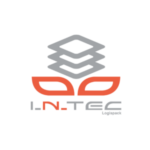
FAQ
A palletizer is a machine or automated system used in warehouses, manufacturing facilities, and distribution centers to arrange and stack products onto pallets for storage, transportation, or further processing. The primary function of a palletizer is to streamline the palletizing process, which involves organizing products in a specific configuration on a pallet to optimize space utilization and ensure stability during handling and transportation.
Key features and functions of palletizers include:
- Product Handling:
- Palletizers are designed to handle a variety of products, including boxes, cartons, bags, containers, and other packaged goods. Some palletizers can also handle different shapes, sizes, and weights of products.
- Automation:
- Palletizers are often automated machines that can operate with minimal human intervention. Robotic palletizers use industrial robots equipped with grippers or suction cups to pick up, move, and place products onto pallets.
- Flexibility:
- Many palletizers are flexible and can be programmed to handle different types of products and pallet configurations. This adaptability is essential in industries where production lines frequently change.
- Layer Formation:
- Palletizers can create specific layers or patterns of products on a pallet, optimizing space and ensuring a stable stack. This may involve alternating layers, interlocking patterns, or specific arrangements based on product characteristics.
- Conveyor Systems:
- Palletizers often integrate with conveyor systems to transport products from the production line to the palletizing area. Conveyors facilitate a continuous flow of products, enabling efficient palletization.
- Pallet Dispensing:
- Some palletizers come with a pallet dispenser that automatically dispenses pallets as needed. This ensures a constant supply of pallets for the palletizing process.
- Safety Features:
- Palletizers include safety features to protect both operators and the equipment. These may include sensors, emergency stop mechanisms, and safety barriers to prevent accidents.
- Software Control:
- Palletizing systems are typically controlled by software that manages the operation of the palletizer. This software may include programming options, monitoring capabilities, and the ability to adjust palletizing parameters.
- Integration with Other Equipment:
- Palletizers can be integrated into larger packaging or warehouse management systems, allowing for seamless coordination with other equipment such as conveyors, stretch wrappers, and labeling machines.
- High-Speed Operation:
- Many palletizers are capable of high-speed operation, contributing to increased production throughput. This is particularly important in industries with high-volume production requirements.
- Customizable Grippers or End-of-Arm Tools:
- Robotic palletizers may feature customizable grippers or end-of-arm tools designed to securely handle various product types and configurations.
- Adaptability to Different Industries:
- Palletizers are used across various industries, including food and beverage, manufacturing, pharmaceuticals, and logistics, reflecting their adaptability to different packaging needs.
Palletizers play a crucial role in optimizing the efficiency of the end-of-line packaging process, reducing manual labor, minimizing errors, and ensuring that products are prepared for storage or transportation in a systematic and organized manner.
Palletizers offer several benefits across various industries by automating the process of stacking and organizing products onto pallets. These advantages contribute to increased efficiency, reduced labor costs, improved safety, and optimized pallet loads. Here are key benefits of using a palletizer:
- Increased Efficiency:
- Palletizers automate the palletizing process, leading to higher efficiency compared to manual stacking. They can operate continuously at high speeds, ensuring a consistent and faster throughput.
- Labor Cost Savings:
- Automation reduces the reliance on manual labor for palletizing tasks. This leads to significant cost savings in terms of labor expenses, and employees can be deployed to more skilled or strategic roles within the organization.
- Consistency in Pallet Loads:
- Palletizers create consistent and uniform pallet loads, minimizing variations in product placement and arrangement. This consistency improves the stability of pallet loads during storage and transportation.
- Optimized Space Utilization:
- Palletizers are programmed to create efficient layer patterns, maximizing the use of space on pallets. This optimization reduces the number of pallets needed for a given volume of products, leading to cost savings in storage and transportation.
- Reduced Product Damage:
- Automated palletizers handle products with precision, reducing the risk of damage caused by manual mishandling. This is especially important for fragile or delicate products that require gentle stacking.
- Flexibility in Product Handling:
- Palletizers are designed to handle a variety of products, including different sizes, shapes, and weights. This flexibility allows manufacturers to adapt to changes in product lines or packaging configurations.
- Increased Throughput:
- Palletizers operate at high speeds, contributing to increased production throughput. This is beneficial for industries with high-volume production demands and tight timelines.
- Improved Workplace Safety:
- Automated palletizing reduces the physical strain on workers associated with manual lifting and stacking. This leads to a safer working environment, minimizing the risk of injuries and ergonomic issues.
- Adaptability to Various Industries:
- Palletizers are used in diverse industries, including food and beverage, manufacturing, pharmaceuticals, and logistics. Their adaptability makes them suitable for a wide range of packaging requirements.
- Integration with Other Equipment:
- Palletizers can be integrated into larger packaging lines or warehouse management systems, allowing for seamless coordination with other equipment such as conveyors, stretch wrappers, and labeling machines.
- Real-time Monitoring and Control:
- Many palletizers come with monitoring and control features that enable operators to oversee the palletizing process in real-time. This capability facilitates quick responses to issues and enhances overall system performance.
- Customizable Grippers:
- Robotic palletizers often feature customizable grippers or end-of-arm tools that can be adapted to handle different product types and configurations.
- Enhanced Product Traceability:
- Integration with tracking and tracing systems improves product traceability throughout the supply chain. This is important for compliance with regulatory standards and efficient recall processes if needed.
The benefits of palletizers include efficiency gains, labor cost savings, consistent pallet loads, space optimization, reduced product damage, flexibility in handling various products, increased throughput, workplace safety improvements, adaptability to different industries, integration capabilities, real-time monitoring, and enhanced traceability. These advantages make palletizers valuable assets in modern manufacturing and distribution operations.
Palletizers are designed to handle a variety of products, including those that may be challenging to stack manually. The capabilities of modern palletizing systems, especially robotic palletizers, allow for the efficient handling of diverse and difficult-to-stack products. Here are types of products that may be considered difficult to stack but can be effectively managed by a palletizer:
- Irregular-Shaped Items:
- Products with irregular shapes, such as non-uniform packaging or asymmetrical containers, can be challenging to stack manually. Palletizers, especially those with robotic arms, can adapt to the shape of the items for precise stacking.
- Bags and Sacks:
- Loose bags or sacks containing granular or powdery materials may be difficult to stack manually due to their tendency to shift. Palletizers can handle bags of various sizes and materials, ensuring stable stacking.
- Mixed Product Pallets:
- Palletizing a mix of different products with varying shapes and sizes on the same pallet can be complex for manual operators. A palletizer can efficiently handle mixed-product palletizing, adjusting its approach based on the diverse SKU configurations.
- Cartons with Varying Dimensions:
- Cartons with different dimensions, varying heights, or lightweight construction can be challenging to stack manually. Palletizers can adapt to the varying dimensions of cartons for efficient and stable stacking.
- Unstable or Fragile Products:
- Fragile items or those with unstable structures that are prone to breakage or deformation can be stacked gently and precisely by a palletizer. These systems often include sensors and adaptive grippers for delicate handling.
- Fresh Produce:
- Fresh produce, with irregular shapes, sizes, and delicate skins, can be challenging to stack manually without causing damage. Palletizers equipped with soft grippers and advanced vision systems can handle fresh produce with care.
- Bulk Items or Large Bags:
- Large bags or bulk items, such as pet food, fertilizer, or seeds, may be difficult to stack manually due to their weight and size. Palletizers, particularly those designed for heavy loads, can handle these products efficiently.
- Automotive Parts:
- Irregularly shaped or heavy automotive parts may be challenging to stack manually. Palletizers with advanced gripping mechanisms can handle these parts effectively, ensuring stable stacking.
- Frozen Food Products:
- Frozen food items with irregular shapes or varying sizes, such as frozen pizzas or irregularly shaped frozen vegetables, can be challenging to stack manually. Robotic palletizers designed for cold environments can handle these products efficiently.
- Large or Bulky Items:
- Products that are large, bulky, or heavy can be difficult to stack manually. Palletizers equipped with robust robotic arms and customizable grippers can efficiently handle these challenging items.
- Difficult-to-Handle Packaging Materials:
- Packaging materials that are slippery, prone to sticking, or challenging to grip manually can be efficiently handled by a palletizer. Advanced gripping mechanisms ensure secure handling.
The adaptability and precision of palletizing systems, particularly robotic palletizers, make them suitable for managing a wide range of challenging products. These systems can be programmed and configured to handle specific product characteristics, ensuring efficient and stable stacking in various industries.
